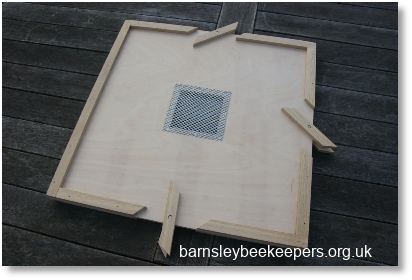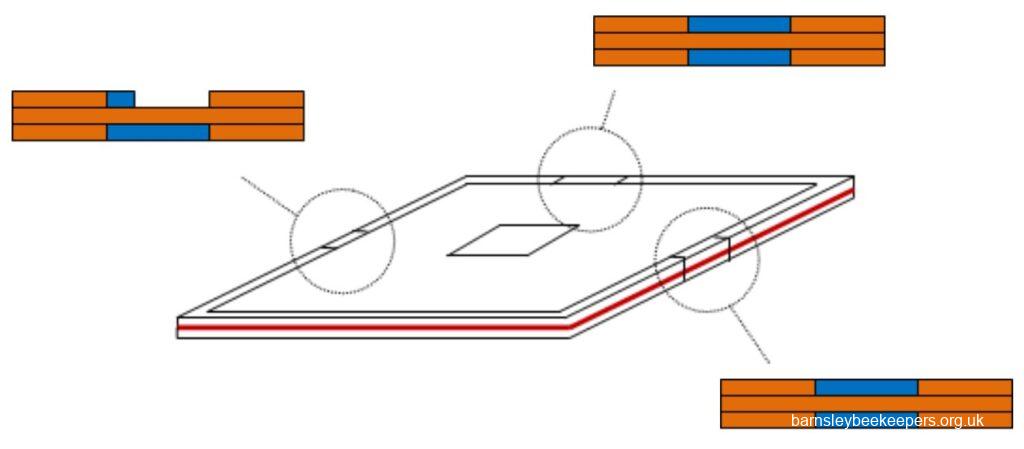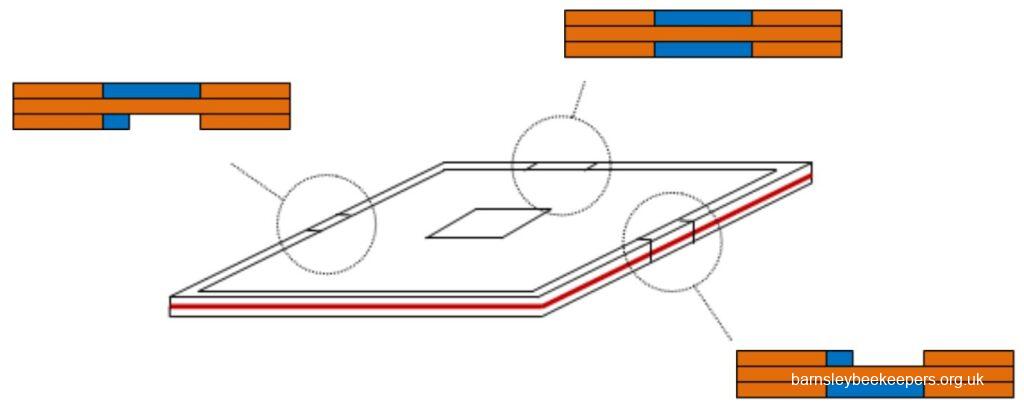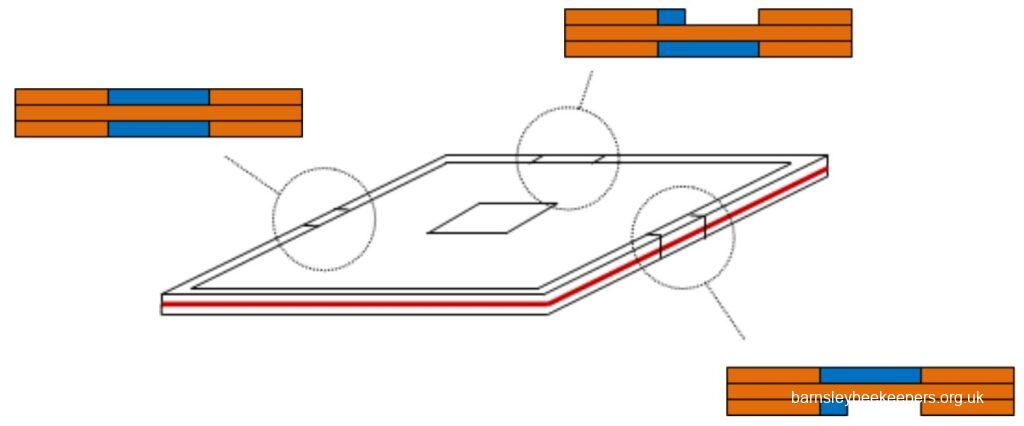The Snelgrove method was first described by Leonard E Snelgrove in his 1934 book, “Swarming – It’s Control and Prevention”. It follows on from decades of hive manipulation using various kinds of board to separate queen from brood. Leonard Snelgrove introduced his specific design of board that makes use of entrances above and below the board to “bleed” bees from one box to another.
The Snelgrove Method
Leonard Snelgrove’s new board was originally intended for swarm prevention (like the demaree method), where the beekeeper would judge when the bees were about ready to swarm before performing the manipulation. However, in his book, he later describes variations that would control swarming and techniques for making increase. Therefore, there is no one specific “snelgrove method”, but instead a common theme based on using a snelgrove board to manage swarming. The method described below attempts to outline the most simple use of the snelgrove board as a method of swarm control.
This method, which can be performed pre-emptively or once queen cells have appeared, involves the temporary separation of the queen and flying bees from the eggs, brood and nurse bees in two separate brood boxes within the same hive. Once the colony is split, one box sits above the others in a vertical arrangement. Snelgrove’s original idea was to use his board to provide the queen with extra laying space whilst maintaining all the bees at full strength in the hive, ultimately as one colony.
Although this modified method has similarities to the demaree method, unlike the latter which maintains an open structure to the hive where bees (other than the queen) can move freely between boxes, snelgrove uses the board to provide complete separation of the bees. The bees’ scent however can still pass through the entire hive via a patch of mesh in the centre of the snelgrove board.
The snelgrove board is largely based on other boards which had been around since the late 19th century. Snelgrove’s modification was to incorporate three pairs of entrances; each pair having one entrance above and one below the board. The entrances could be opened and closed in a sequence that resulted in newly flying bees being “bled” back down into the main productive hive.
The timings of the entrance manipulations are only critical where the beekeeper wishes to use the technique to raise one or more new queens.

A Snelgrove board with 3 pairs of entrances 
Each pair has an entrance above and below the board
Keys to Success
The key to the success of the Snelgrove method are:
- Preparedness (having the necessary extra equipment ready in advance)
- Recognising the signs of imminent swarming or carrying out regular (7 day) inspection from April onward to find queen cells
- Having a marked queen to aid the finding and isolation of her
- Timing of the manipulations (if one or more new queen is desired)
Method
Day 1 –
- Have prepared a second brood box with foundation and/or drawn comb.
- Remove the roof, supers, etc from the mother colony and find the queen (hold her in place with a marking cage to prevent losing her during subsequent manipulations).
- Place the second box on the old floor and remove a couple of frames from the centre to make a gap.
- Place the queen on a frame containing unsealed brood in the gap in the second box, ensuring there are no queen cells on this frame. Remove the marking cage, close up the gap and add a spare frame to the edge.
- Check the mother box for queen cells and (if any) remove all queen cells.
- Rebuild the hive with the queen excluder followed by the supers, snelgrove board, mother brood box, crown board and roof. Locate the snelgrove board so that the side without an entrance faces the front (same side as the main hive entrance).
- Open the top left entrance of the snelgrove board and close all others (the flying bees will return to the main entrance at the front of the hive).

Day 4 or 5-
- Without opening up the hive, close the top left and open the bottom left and top right.

Day 9 or 10 –
- Inspect the top, mother box for any queen cells which may have been created and remove all but the best ones required for developing a second colony or for making up nuclei (or remove all if no increase is sought). At this stage, the bees have no viable eggs or larvae from which to make any further queen cells.
- Close the bottom left and top right entrances and open the bottom right and rear top entrances.

What next?
At this stage the colony has been artificially swarmed and has undergone 3 lots of depletion of flying bees (the initial return of flying bees to the main entrance followed by two manipulations sending bees below the board).
What happens now depends on whether or not the beekeeper intends to make increase.
No Increase – If no increase is sought and no queen cells were allowed to develop, either:
- Relocate the top box beneath the queen excluder to make double brood or,
- Remove the board allowing the remaining brood to emerge over the next couple of weeks. After this the top box can be removed.
If a queen has been allowed to develop and becomes successfully mated, she can used to requeen the main colony by uniting the 2 colonies. Despite their being a match of mesh between the 2 colonies allowing scent to pass through, it is still advisable to use a sheet of newspaper to unite the colonies. The doors to the snelgrove board should be left alone to allow the queen to fly.
Making Increase – If the intention is to raise a new colony from the top box, the entrances to the snelgrove board should be left alone for the new queen to emerge. Assuming that all queen cells were removed on day 1, any new queen cells will have been raised from that point onwards. Any new queen will emerge 14 to 16 days after the initial hive split (depending on whether an egg or lave was used) and no further manipulation of the doors to the snelgrove board should take place. Once the queen is mated and laying, the top box can be relocated to form a new, separate colony.
If more than one queen cell was left in the top mother box in order to make up nuclei, these will need dealing with once the queen cells have matured to the point of being sealed or almost sealed and certainly before they emerge.
The snelgrove board is useful for making increase. Although it can be used purely to prevent swarming, the separation of the mother colony from the queen often leads to the production of multiple emergency queen cells. If the bees are naturally due to swarm, then the queens raised will generally be good ones. If the procedure is performed too early in the season, the emergency cells are more likely to result in poor queens.
This method is given as guidance only. After trying one or more key methods of swarm control, the beekeeper should go on to experiment and develop their own variations to suit their own preferences.
03/04/21- The following information was sent to us by Bob from Holyoke, Massachusetts, USA. Thanks Bob.
Method 2 if the colony has queen cells developing:
1st DAY. Separate combs and place them as follows:
In box A:- (a) The queen. (b) All the brood, with adhering bees. (c) All the queen cells.
In box B:- (a) The combs without brood, with adhering bees. (b) One comb of sealed brood.
Rebuild the hive in the following order:- Floorboard, Box B, Super, Excluder, Box A. (Plate IV, Fig. 5.)
2nd DAY, (or on 1st DAY if there are sealed queen cells).
Place screen board under A and the excluder between B and the Super. (Plate IV, Fig. 6.)
Withdraw wedge 5 leaving the other wedges in position in the board.
5th DAY.
Replace wedge 5 and remove wedge 6. Remove wedge 3 on the side, of the hive.
7th DAY, (or when queen cells have been completely destroyed).
Transfer the queen with a frame of brood and bees from A to B. (Plate IV, Fig. 7.)
21st DAY (or 14th DAY AFTER TRANSFER OF QUEEN).
Replace wedge 3 and remove wedge 4
Open wedge I at the other side of the hive.
(BOB’s comments) A new queen will now have emerged. Mating by day 25 and laying by day 35. Consideration now must be made how to dispose of the new colony in A.


 Swarm Season is here!
Swarm Season is here!